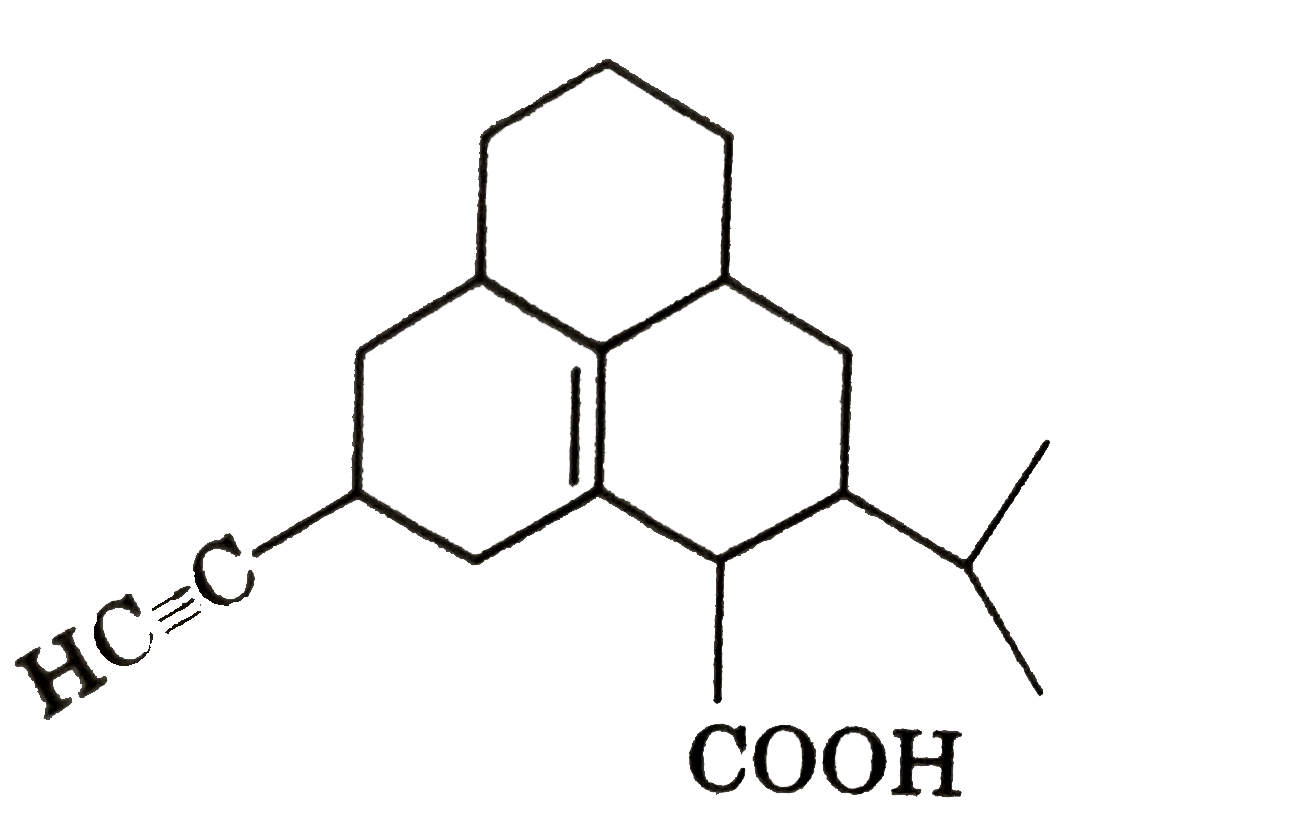We know that carbon has the unique property to form bonds with other atoms of carbon. Now observe the below given chain of carbon atoms and answer the questions.
| ||−C−C−C− |−C− |
The number of single bonds present in this compound (cyclohexane) is :
12
14
16
18
The correct Answer is:D
To determine the number of single bonds present in cyclohexane, we can follow these steps:
Step 1: Understand the Structure of Cyclohexane
Cyclohexane is a cyclic compound with the formula C6H12. It consists of 6 carbon atoms arranged in a ring. Each carbon atom in cyclohexane is bonded to two other carbon atoms and two hydrogen atoms.
Step 2: Count the Carbon-Carbon (C-C) Bonds
In cyclohexane, each carbon atom is connected to two other carbon atoms. Since there are 6 carbon atoms in a ring, the number of carbon-carbon bonds can be calculated as follows:
- Each of the 6 carbon atoms forms 1 bond with its two neighboring carbon atoms.
- Therefore, the total number of C-C bonds is equal to the number of carbon atoms, which is 6.
Step 3: Count the Carbon-Hydrogen (C-H) Bonds
Each carbon atom in cyclohexane is also bonded to 2 hydrogen atoms. Therefore, the total number of C-H bonds can be calculated as follows:
- Since there are 6 carbon atoms and each is bonded to 2 hydrogen atoms, the total number of C-H bonds is:
6 (C atoms)×2 (H atoms per C)=12 C-H bonds
Step 4: Calculate the Total Number of Single Bonds
Now, we can add the number of C-C bonds and C-H bonds to find the total number of single bonds in cyclohexane:
- Total single bonds = Number of C-C bonds + Number of C-H bonds
- Total single bonds = 6 (C-C) + 12 (C-H) = 18 single bonds
Final Answer
The total number of single bonds present in cyclohexane is 18.
---
Cyclohexane is a cyclic compound with the formula C6H12. It consists of 6 carbon atoms arranged in a ring. Each carbon atom in cyclohexane is bonded to two other carbon atoms and two hydrogen atoms.
In cyclohexane, each carbon atom is connected to two other carbon atoms. Since there are 6 carbon atoms in a ring, the number of carbon-carbon bonds can be calculated as follows:
- Each of the 6 carbon atoms forms 1 bond with its two neighboring carbon atoms.
- Therefore, the total number of C-C bonds is equal to the number of carbon atoms, which is 6.
Each carbon atom in cyclohexane is also bonded to 2 hydrogen atoms. Therefore, the total number of C-H bonds can be calculated as follows:
- Since there are 6 carbon atoms and each is bonded to 2 hydrogen atoms, the total number of C-H bonds is:
6 (C atoms)×2 (H atoms per C)=12 C-H bonds
Now, we can add the number of C-C bonds and C-H bonds to find the total number of single bonds in cyclohexane:
- Total single bonds = Number of C-C bonds + Number of C-H bonds
- Total single bonds = 6 (C-C) + 12 (C-H) = 18 single bonds
The total number of single bonds present in cyclohexane is 18.
Topper's Solved these Questions
- NEW CHAPTERS AND QUESTIONS BASED ON LATEST TYPOLOGIES INTRODUCED BY CBSE FOR 2021-22 EXAMINATION BOOK - OSWAL PUBLICATIONCHAPTER - NEW CHAPTERS AND QUESTIONS BASED ON LATEST TYPOLOGIES INTRODUCED BY CBSE FOR 2021-22 EXAMINATION EXERCISE - PERIODIC CLASSIFICATION OF ELEMENTS (VISUAL CASE - BASED QUESTIONS)
15 Videos
- NEW CHAPTERS AND QUESTIONS BASED ON LATEST TYPOLOGIES INTRODUCED BY CBSE FOR 2021-22 EXAMINATION BOOK - OSWAL PUBLICATIONCHAPTER - NEW CHAPTERS AND QUESTIONS BASED ON LATEST TYPOLOGIES INTRODUCED BY CBSE FOR 2021-22 EXAMINATION EXERCISE - CARBON AND ITS COMPOUNDS (SELF ASSESSMENT) ( LONG ANSWER TYPE QUESTIONS)
1 Videos
- METALS AND NON-METALSBOOK - OSWAL PUBLICATIONCHAPTER - METALS AND NON-METALSEXERCISE - Board corner(Long answer type questions)
20 Videos
- NTSE 2019 - 20 BOOK - OSWAL PUBLICATIONCHAPTER - NTSE 2019 - 20 EXERCISE - (CHEMISTRY) ATOMS AND MOLECULES (STAGE - 2)
1 Videos
Similar Questions
Knowledge Check
We know that carbon has the unique property to form bonds with other atoms of carbon. Now observe the below given chain of carbon atoms and answer the questions.
| ||−C−C−C− |−C− |
Give reasons for this unique property of carbon.ACatenation property and tetravalencyBIsomerism and covalencyCAllotropy and bivalencyDHomologous series and covalencyWe know that carbon has the unique property to form bonds with other atoms of carbon. Now observe the below given chain of carbon atoms and answer the questions.
| ||−C−C−C− |−C− |
The characteristic property of carbon as depicted in the chain is :AAllotropyBCatenationCIsomerisationDHalogenationCarbon forms bonds with other atoms
Aby gaining electronsBby losing electrons.Cby sharing electronsDnone of the above
Total number of 3∘ carbon atoms present in compound given below:

View SolutionWe know that carbon has the unique property to form bonds with other atoms of carbon. Now observe the below given chain of carbon atoms and answer the questions.
| ||−C−C−C− |−C− |
The name of a saturated compound in which the carbon atoms are arranged in a ring is :
View SolutionWe know that carbon has the unique property to form bonds with other atoms of carbon. Now observe the below given chain of carbon atoms and answer the questions.
| ||−C−C−C− |−C− |
Which of the following statements are correct for carbon compounds?
(1) Most carbon compounds are good conductors of electricity.
(2) Most carbon compounds are poor conductors of electricity.
(3) Force of attraction between molecules of carbon compounds are not very strong.
(4) Force of attraction between molecules of carbon compounds are very strong.
View SolutionCarbon has the unique property to form bonds with other atoms of carbon.
−∣C−∣C−∣C∣−−∣C−
Carbon is:
View SolutionAssertion (A) : Carbon has the ability to form bonds with other carbon atoms, giving rise to large molecules.
Reason (R) : Carbon-carbon is a stable bond.
View Solution
